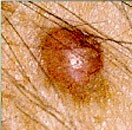
WEDNESDAY, Jan. 18 (HealthDay News) — The recently approved drug vemurafenib (Zelboraf) has been hailed as a breakthrough in the treatment of melanoma, the deadliest form of skin cancer. But roughly one-quarter of patients who take the medication develop a troublesome side effect: secondary skin cancers called squamous cell carcinomas.
Now, a new study by researchers at the Jonsson Comprehensive Cancer Center at the University of California, Los Angeles, and colleagues identifies the specific genetic mechanism that causes this side effect.
“What we found is that vemurafenib blocks the mutation that makes the melanoma grow, but when patients have skin cells with another mutation that’s probably induced from sun exposure, there the drug has the exact opposite effect and causes these squamous cell cancers to grow,” said Dr. Antoni Ribas, co-senior author of the study and an associate professor of hematology/oncology at UCLA.
What’s more, the findings suggest that combining vemurafenib, a BRAF inhibitor, with a drug called an MEK inhibitor — which blocks the other mutation — may not only prevent this side effect, but may also lead to an even more effective melanoma treatment, Ribas said.
“It needs to be demonstrated in clinical trials, but the theory is that if we give these two medications together up front, we will be punching the melanoma where it really hurts twice, and also preventing the growth of secondary skin cancers,” Ribas said.
For the study, which appears in the Jan. 19 issue of the New England Journal of Medicine, Ribas and his colleagues analyzed cells from squamous cell lesions in patients treated with vemurafenib to look for specific genetic mutations.
In a set of 21 tumor samples, the researchers found 13 had what’s known as an RAS mutation, which predisposes someone to develop squamous cell cancer. In a separate set of 14 samples, eight had RAS mutations.
“Our data suggest that about 60 percent of patients who develop skin squamous cell cancers while treated with a BRAF inhibitor have an RAS mutation,” Ribas said.
In experiments in mice with the RAS mutation, the researchers showed that the combination of a BRAF inhibitor and an MEK inhibitor successfully
blocked the growth of squamous cell cancers.
This result may need replication in humans, since many findings in animals do not translate into effective treatments for people.
Ribas noted that the findings have implications beyond just melanoma, since RAS mutations are common in lung, pancreatic and colon cancer. “What this data also warns us is that we have to be very careful about using BRAF inhibitors in a setting where we don’t know what other mutations may be driving [the cancer],” he said.
In an editorial accompanying the study, a cancer researcher at the Wistar Institute in Philadelphia sounded a similar note. “Patients being given BRAF inhibitors should be tested to determine their RAS status, since the potential for secondary tumor development is of concern,” wrote Ashani Weeraratna, an assistant professor in Wistar’s Molecular and Cellular Oncogenesis Program.
In an interview, she added, “While cutaneous squamous cell carcinomas are not usually life-threatening, a small portion are. And further, squamous cell carcinomas of other cell types can be very aggressive. So understanding how to solve this problem is critical.”
Another skin cancer expert said that although the findings were important and timely, more studies were needed before making broad recommendations. “Patients need to be aware of the risk of development of squamous cell carcinomas, and dermatology exams need to be included as part of the care for these patients,” said Dr. Iman Osman, an associate professor of dermatology and oncology at NYU Langone Medical Center in New York City.
“I believe any other recommendation, such as adding a MEK inhibitor from the beginning, or doing biopsies of any squamous cell carcinoma for RAS mutation at the time of starting BRAF inhibition, will require more data,” Osman said.
Other researchers who took part in the study included investigators from the Institute of Cancer Research in London and the pharmaceutical companies Roche and Plexxikon.
More information
Visit the U.S. National Cancer Institute to learn about melanoma.

